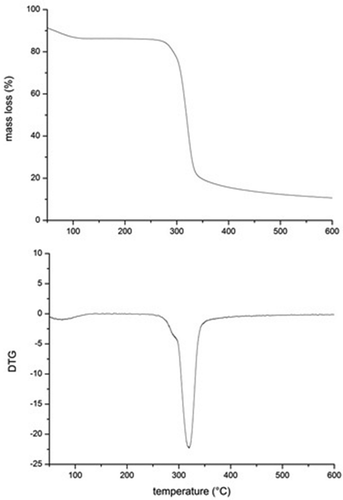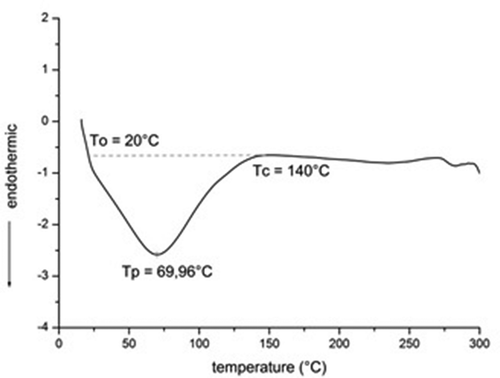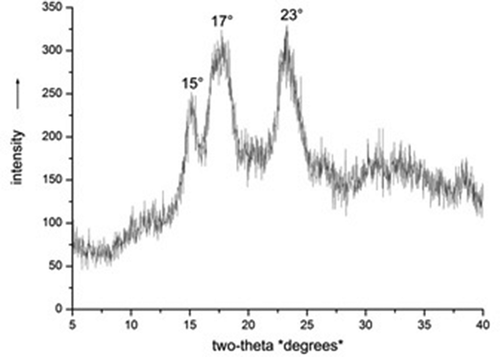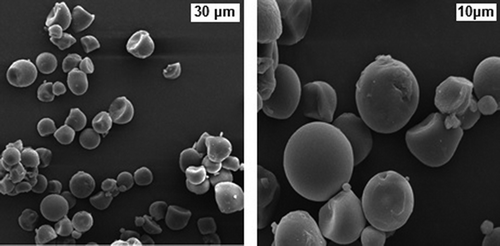ABSTRACT
The objective of this study was to characterize the starch of the peach-palm fruit. The starch was subjected to thermogravimetric analysis, differential scanning calorimetry, Fourier transform infrared spectroscopy, x-ray diffraction, and scanning electron microscopy. The thermogravimetric analysis showed 76.62% of the weight loss in the temperature range from 251.7 to 380.6 ºC. The peak in differential scanning calorimetry was obtained at 70.0 ºC. Fourier transform infrared spectroscopy were obtained with a wavelength band of 528 to 3421 cm−1. The x-ray diffraction corresponded to C-type crystals. The granule sizes ranged from 1.60 to 8.48 μm.
Introduction
Starch is the carbohydrate of plant reserves, extracted from the edible parts of cereals, tubercles, fruits, roots, and rhizomes. It is mainly composed of two polysaccharides, both formed by repetitive units of α-D glucose: amylose, an essentially linear molecule, and amylopectin, which has a highly branched structure. It occurs as small, semicrystalline granules.[Citation1] Many authors consider starch to be the main source of energy storage of higher plants, as well as the food source responsible for 70 to 80% of the calories consumed by man. Due to its physicochemical and functional properties, this carbohydrate is very important in various industrial sectors.
The commercial extraction of starch is still restricted to cereals and tubercles. However, the industry is interested in identifying and developing cultures that produce native starches with specific characteristics, such as starch peas,[Citation2] beans,[Citation3,Citation4] bananas,[Citation5–Citation7] ginkgo,[Citation8,Citation9] jackfruit seeds,[Citation10] and pejibaye.[Citation11,Citation12] The starch from the pejibaye represents a viable alternative for commercial application due to its chemical characteristics and functional properties of industrial interest. According to the literature,[Citation12] the fruit has high levels of amylose, low levels of lipids, proteins and ash, low solubility in water, and a gelatinization temperature similar to that of traditional starch sources. In particular, the amylose content in starch from pejibaye indicates that this powder could be used as raw material for films, coatings, and packaging to be used in food products.[Citation11]
An understanding of the structure of starch granules and their physical, morphological, and thermal properties are important because these factors determine starch behavior in many different industrial processes.[Citation13,Citation14] During the agroindustrial harvesting of peach-palm, large volumes of wastes are generated, both in the field and in industrialized contexts. Despite the potential use of the pejibaye, mainly as human food, most of its production is devoted to obtaining seeds, since Brazil imposes strict sanitary barriers regarding importation, due to the risk of introducing quarantine pests, especially cocoa moniliasis. Thus, pejibaye pulp, rich in starch, is underutilized.[Citation12] The extraction of pejibaye starch, then, would add value to a product that is currently considered a waste product of heart of palm extraction from the peach-palm and would also contribute to a reduction of the environmental impact of such waste.
The utilization of these wastes as a raw material is a rational alternative, because their source is abundant, renewable, and of great industrial interest. Considering that there is little information about this product, the objective of this work is to characterise pejibaye starch with respect to its morphological and thermal characteristics. Thus, pejibaye starch was analyzed using the thermogravimetric analysis (TGA) and differential scanning calorimetry (DSC) to measure thermal behavior, Fourier transform infrared spectroscopy (FTIR) to determine the amount of different chemical bonds present in starch, x-ray diffraction (DRX) to determine the crystalline pattern, and scanning electron microscopy (SEM) to determine the size and shape of the granules.
Materials and methods
Materials
Plantations owned by the Baiano Federal Institute, Uruçuca Campus and by INACERES S.A. supplied the mature pejibaye. Additional materials were ice water at 5°C, sodium hydroxide (NaOH) P.A., sodium bisulphite (NaHSO3) P.A., and absolute ethyl alcohol. All analytical grade reactants were manufactured by the Synth Company.
Methods
Starch extraction
Starch was obtained from the pejibaye fruit according to the methodology described in the literature.[Citation1,Citation12] The fruits were peeled, shredded, and put into plastic containers, for 5 h. A “Croton” type knife mill with a 10 mesh (2.0-mm) screen ground the samples in order to separate the mulch from the starch milk, which was purified in 100 and 200 mesh (0.149- and 0.079-mm) sieves. The mulch was then successively washed with running water in order to separate the starch by decanting into plastic containers. The decanted starch was purified with absolute alcohol, filtered, and dehydrated at 35°C for 12 h in a dryer containing silica gel. The starch obtained was then reduced to powder and passed through a 48 mesh (0.389-mm) sieve in order to obtain the sample for analysis. The sample for analysis comprised starch at an amylose/amylopectin ratio of 1:5.[Citation12]
TGA
The thermal stability of the pejibaye starch was assessed utilizing a Perkin Elmer model STA 6000 thermogravimetric analyser, assisted by Pyris Series software. The TGA thermogram was obtained in the temperature range of 35 to 600ºC, with a heating rate of 10ºC/min. The analyses were conducted in a nitrogen atmosphere, at a flow rate of 20 mL/min.
DSC
The thermal properties of the pejibaye starch were assessed using a Shimadzu model DSC-60 differential scanning calorimeter. A 3.0-mg sample of starch was weighed in an aluminium pan (capsule). The capsule was hermetically closed and temperature balanced at room temperature for 1 h. The calibration of the system was achieved with metallic indium, using an empty aluminium capsule as reference. The analysis was conducted at a temperature range of 10 to 300°C, with a heating rate of 10ºC/min. The thermal transitions of the starch samples were defined as initial (original) temperature (To), peak temperature (Tp), final temperature (Tf) and gelatinization enthalpy (∆Hgel).
FTIR
The FTIR spectra of the pejibaye starch were generated utilising a mid-IR Thermo Electron Corporation model Nicolet 6700 spectrometer. The wavelength utilized was in the range of 4000 to 400 cm−1.
DRX
DRX of the pejibaye starch was performed using a Shimadzu diffractometer model XDR-7000 with operating voltage of 30 kV, 10 mA. The assay was performed at room temperature (25°C) with angle 2θ between 5 and 40° (0.5° min−1).
SEM
SEM images of the pejibaye starch were obtained with an FEI Company model QUANTA 400 scanning electron microscope, with a maximum operating voltage of 30 kV and nominal resolution of 1.2 nm, in a high vacuum at a voltage of 20 kV. The images were acquired with a secondary electron detector. The starch was affixed on a gold-coated specimen dish.
Results and discussion
TGA
shows the TGA and DTG thermograms of the pejibaye starch, which reveal two main thermal events. The first event is represented by a discrete peak, where 8.9 % of the initial mass is lost from the beginning of the analysis up to the temperature of 129.3ºC, while the maximum loss occurs at 74.7ºC (0.10%/ºC). That peak represents the evaporation of water present in the starch granules. The second peak event is represented by a sharp peak, where 76.6% of the mass is lost in the temperature range from 251.7 to 380.6ºC, while the maximum loss occurs at 320ºC (2.2%/ºC). That peak likely represents degradation of the glucose ring in the polymers of the starch, amylose and/or amylopectin.
A similar thermal degradation of the starch of the cashew nut was observed after oil removal, with the maximum degradation rate of the glucose ring occurring at 319ºC but starting at 174ºC. Found[Citation16] reported the start of that degradation at 220ºC for starch from corn. Published reports, aside from finding the start of the degradation of the glucose from rice starch at 210ºC, found a third thermal event that ended at 540ºC.[Citation17] These results suggest that the starch from pejibaye has superior thermal stability compared to other starches and can be processed up to a temperature of 251.7ºC.
DSC
The results of the DSC analysis of pejibaye starch are shown in . It can be seen that starch gelatinization occurred at 70ºC (Tp). The peak obtained represents the endothermic gelatinisation reaction, which is an order–disorder phase transition of the starch that occurs when it is heated in the presence of excess water, during a temperature interval characteristic of the starch source. compares peak temperature (Tp) and gelatinization enthalpy (ΔH) of the pejibaye starch with values reported for other starch sources. The thermal properties of the pejibaye starch are in accordance with others found in the literature (ΔH = 15.7 J.g−1).
Table 1. Thermal properties of the starch from the pejibaye and other starch sources studied in the literature.
Enthalpy of the pejibaye starch reflects the presence of short chains in the amylopectin, which comprises approximately 84.3% amylopectin and 15.7% amylose.[Citation12,Citation18] The starting temperature for gelatinization occurs when water enters the amorphous region and becomes less ordered. Due to the high concentration of amylopectin, the structure limits the accessibility of water, thus delaying gelatinization. This leads to a wider interval between initial and ending temperatures, due to the slow gelatinization of the more crystalline regions.[Citation19,Citation20] Based on the DSC results, it can be said that the granules are resistant and less susceptible to breakage with prolonged heating.[Citation21]
FTIR
The results obtained from the FTIR analysis of the pejibaye starch are shown in . Because the starch is comprised mainly of amylose, amylopectin, and water, the spectral bands are attributed to the bonds between the atoms of those molecules.[Citation22] The presence of a strong band can be observed, wide and rounded, in the region of the 3400-nm wavelength. A nearby band was observed in starch from Cissus simsiana Roem. & Schult. (3453.04 nm), which is characteristic of hydrogen bonds of the hydroxyl groups present in the D-glucose unit of starches from different botanical sources.[Citation11,Citation12,Citation23,Citation24] Bands corresponding to CH bonds of the ring and the stretching of the glycosidic CO bond were also identified, with band wavelengths of 2931 and 1150 nm, respectively. The value of the CH band was close to that found in the literature[Citation23] (2923 nm) for manioc starch. The value of the CO band (1150 nm) in starch from Colombian pejibaye was previously reported.[Citation11] The literature includes evidence for detected peaks in the spectral bands of maximum absorbency between 854 and 1007.50 nm, similar to those found in the starch of this study (1080 and 1018 nm).[Citation11,Citation22] Normally, the bands that appear in the region between 1080 and 990 nm are attributed to the asymmetrical axial vibration of COC, the axial vibration of CO, and the axial vibration of the main chain.[Citation24] The other peaks observed are associated with the deformation of lateral COH, CCH, and OCH groups containing stretched CC bonds (950–700 nm), with the regions of the skeleton of the molecule containing exocyclic deformations (700–500 nm).[Citation25]
DRX
There are three types of DRX patterns for starch: The A-type consists of double helices made by compressed amylose and amylopectin, often found in cereals; the B-type consists of structure highly hydrated with double helices arranged into a hexagon, typical of tubers and root starches[Citation26,Citation27] and the C type. With regard to the C-type, the available literature is divergent. Some have reported the C pattern as a mixture of A-type and B-type, and thus crystals present proportions of each.[Citation28] In the literature,[Citation29] pattern C is a distinct structure and not a mixture of patterns A and B. The DRX result of the analysis of starch granules from pejibaye is shown in . It can be seen that the starch has a diffraction pattern of type C with peak 2Ɵ angles near 15, 17, and 23°. The pejibaye starch studied[Citation11] originated in Colombia and revealed standard type A, with similar peaks. According to the literature,[Citation30] starches that have type A or C are more resistant to enzymatic attack, suggesting more homogeneous granules with respect to the distribution of internal forces. Type C standard diffractograms were also found in starches from other sources, as in starch ginkgo (Ginkgo biloba L.),[Citation8] field pea (Pisum sativum L.) cultivars,[Citation2] in starch granules[Citation6] from banana (Musa AAB-Terra), green cowpea[Citation4] (Vigna unguiculata L. Walp.), chickpea[Citation20] (Cicer arietinum L.), and Trichosanthes kirilowii Maxim.[Citation31]
SEM
The shape and size of the starch granules from the pejibaye are shown in . The granules are predominantly spherical, with regular particles, smooth surfaces, and few cracks, where few particles show spherical deformation. These characteristics are similar to those observed in starch granules from chickpeas (Cicer arietinum L.)[Citation20] and commercial potatoes (Solanum tuberosum L.).[Citation32] However, these granules differ from the starch granules from other sources: saffron (Curcuma longa L. and Curcuma zedoaria [Christm.] Roscoe), which has a flattened triangular shape;[Citation33] granules of corn, which are polyhedral;[Citation6] granules of wheat, which are lenticular;[Citation4] and granules of banana (Musa × paradisiaca L.), which are elongated.[Citation7] Concerning size, granule diameter varied from 1.6–8.5 μm. Such values are approximate, due to the irregularity and diversity of their natural shapes. The diameter of pejibaye starch granules is close to the size observed for: commercial corn starch,[Citation34] starch from commercial rice (1.5–9 μm);[Citation4] starch from jackfruit (Artocarpus heterophyllus Lam.) pulp (1–18 μm),[Citation7] and starch from jackfruit (Artocarpus heterophyllus Lam.) seeds (1–18 μm).[Citation7] Starch with small granules has better digestibility after cooking due to the higher surface area in relation to volume.[Citation4] For Aldana et al.,[Citation10] the small size of starch granules can be important for several applications, such as encapsulation and products with high water retention.
Conclusions
This study compared the morphological and thermal properties of starch from the pejibaye. The starch has small granules with association components that form its matrix, thus explaining the transitions found. In general, properties were similar to those from other starch sources reported in the literature, but the granules were more resistant and less susceptible to breakage with prolonged heating. Characterization of the pejibaye suggested its potential for industrial applications, including food and non-food uses, as in films and coatings, as well as in biodegradable packaging.
Funding
The authors thank Fundação de Amparo a Pesquisa do Estado da Bahia (FAPESB), Coordenação de Aperfeiçoamento de Pessoal de Nível Superior (CAPES), and Conselho Nacional de Desenvolvimento Científico e Tecnológico (CNPq), for the financial support required for this research.
Additional information
Funding
References
- Leonel, M.; Sarmento, S.B.S; Cereda, M.P.; Câmara, F.L.A. Extração e Caracterização de Amido de Jacatupé (Pachyrhizus Ahipa). Ciência e Tecnologia de Alimentos [Extraction and characterization of yam bean starch (Pachyrhizus Ahipa). Science and Technology Food] 2003, 23, 362–365.
- Ratnayake, W.S.; Hoover, R.; Shahidi, F.; Perera, C.; Jane, J. Composition, Molecular Structure, and Physicochemical Properties of Starches from Four Field Pea (Pisum Sativum L.) Cultivars. Food Chemistry 2001, 74, 189–202.
- Mélo, E.A.; Stamford, T.L.M.; Silva, M.P.C.; Krieger, N.; Stamford, N.P. Functional Properties of Yam Bean (Pachyrhizus Erosus) Starch. Bioresource Technology 2003, 89, 103–106.
- Salgado, S.M.; Guerra, N.B.; Andrade, S.A.C.; Olivera, A.V.S. Caracterização Físico-Química do Grânulo do Amido do Feijão-Caupi. Ciência e Tecnologia de Alimentos [Characterization physical chemistry granules starch bean-cowpea. Science and Technology Food] 2005, 25, 525–530.
- Zhang, P.; Whistler, R.L.; Bemiller, J.N.; Hamaker, B.R. Banana Starch: Production, Physicochemical Properties, and Digestibility—A Review. Carbohydrate Polymers 2005, 59, 443–458.
- Freitas, M.C.J.; Tavares, D.Q. Caracterização do Grânulo de Amido de Bananas (Aaa-Nanicão de ab-Terra) Musa. Ciência e Tecnologia de Alimentos [Granules characterization of bananas starch (AAA Nanicão e AB Terra) Musa. Science and Technology Food] 2005, 25, 217–222.
- Pelissari, F.M.; Andrade-Mahecha, M.M.; Sobral, P.J.D.A.; Menegalli, F.C. Isolation and Characterization of the Flour and Starch of Plantain Bananas (Musa Paradisiaca). Starch-Stärke 2012, 64, 382–391.
- Spence, K.E.; Jane, J. Chemical and Physical Properties of Ginkgo (Ginkgo Biloba) Starch. Carbohydrate Polymers 1999, 40, 261–269.
- Miao, M.; Jiang, H.; Jiang, B.; Cui, S.W.; Jin, Z.; Zhang, T. Structure and Functional Properties of Starches from Chinese Ginkgo (Ginkgo Biloba L.) Nuts. Food Research International 2012, 49, 303–310.
- Aldana, M.D.L.; Gómez, T.B.; Oca, M.M.M.; Ayerdi, S.S.G.; Meraz, G.F.; Pérez, B.L.A. Isolation and Characterization of Mexican Jackfruit (Artocarpus Heterophyllus L) Seeds Starch in Two Mature Stages. Starch-Stärke 2011, 63, 364–372.
- Valencia, G.A.; Moraes, I.C.F.; Lourenço, R.V.; Bittante, A.M.Q.B.; Sobral, P.J.D.A. Physicochemical, Morphological, and Functional Properties of Flour and Starch from Peach Palm (Bactris Gasipaes K.) Fruit. Starch‐Stärke 2015, 67, 163–173.
- Melo Neto, B.A.; Barbosa, A.A.; Santos Leite, C.X.; Almeida, P.F.; Bonomo, R.C.F.; Pontes, K.V. Chemical Composition and Functional Properties of Starch Extracted from the Pejibaye Fruit (Bactris Gasepaes Kunth.). Acta Scientiarum. Technology 2015, 37, 105–110.
- Bemiller, J.N. Starch Modification: Challenges and Prospects. Starch‐Stärke 1997, 49, 127–131.
- Rocha, T.S.; Demiate, I.M.; Franco, C.M.L. Características Estruturais e Físico-Químicas de Amidos de Mandioquinha-Salsa (Arracacia Xanthorrhiza). Ciência Tecnologia de Alimentos [Structural characteristics and physical-chemical starches arracacha (Arracacia xanthorrhiza). Science and Technology Food] 2008, 28, 620–628.
- Yuliana, M.; Huynh, L.H.; Ho, Q.P.; Truong, C.T.; Ju, Y.H. Defatted Cashew Nut Shell Starch as Renewable Polymeric Material: Isolation and Characterization. Carbohydrate Polymers 2012, 87, 2576–2581.
- Liu, X.; Yu, L.; Liu, H.; Chen, L.; Li, L. Thermal Decomposition of Corn Starch with Different Amylose/Amylopectin Ratios in Open and Sealed Systems. Cereal Chemistry 2009, 86, 383–385.
- Fabian, C.; Ayucitra, A.; Ismadji, S.; Ju, Y.H. Isolation and Characterization of Starch from Defatted Rice Bran. Journal of the Taiwan Institute of Chemical Engineers 2011, 42, 86–91.
- Yonemoto, P.G.; Calori-Domingues, M.A.; Franco, C.M.L. Efeito do Tamanho dos Grânulos nas Características Estruturais e Físico-Químicas do Amido de Trigo. Ciência e Tecnologia de Alimentos 2007, 27, 761–771.
- Noda, T.; Tsuda, S.; Mori, M.; Takigawa, S.; Matsuura-Endo, C.; Kim, S.-J.; Hashimoto, N.; Yamauchi, H. Determination of the Phosphorus Content in Potato Starch using an Energy Dispersive X-Ray Fluorescence Method. Food Chemistry 2006, 95, 632–637.
- Oliveira, T.M.D.; Pirozi, M.R.; Borges, J.T.D.S.; Germani, R.; Fontes, M.P.F. Caracterização do Amido de Grão-de-Bico (Cicer Arietinum L). Boletim do Centro Pesquisa e Processamento de Alimentos [Characterization of chickpea starch (Cicer arietinum L). Bulletin Research and Food Processing Center] 2009, 27, 27–42.
- Ascheri, D.P.R.; Moura, W.S.; Ascheri, J.L.R.; Carvalho, C.W.P. Caracterização Física e Físico-Química dos Rizomas e do Amido do Lírio-Do-Brejo (Hedychium Coronarium). Pesquisa Agropecuária Tropical [Characterization physics and physical chemistry of rhizomes and starch lily of the swamp (Hedychium coronarium). Tropical Agricultural Research] 2010, 4, 159–166.
- Ascheri, D.P.R.; Morais, C.C.; Asquieri, E.R.; Carvalho, C.W.P.; Ascheri, J.L.R. Characterization of Starch Extracted from the Roots of Cissus Simsiana Roem. & Schult. Semina: Ciências Agrárias 2014, 2, 787–800.
- Wang, P.X.; Wu, X.L.; Dong-Hua, X.; Kun, X.; Ying, T.; Xi-Bing, D.; Wen-Bo, L. Preparation and Characterization of Cationic Corn Starch with a High Degree of Substitution in Dioxane–the–Water Media. Carbohydrate Research 2009, 344, 851–855.
- Mina, J.; González, V.A.; Franco, H.P.; Zuluaga, F.; Delvasto, S. Physicochemical Characterization of Natural and Acetylated Thermoplastic Cassava Starch. Dyna 2011, 78, 166–1731.
- Sandle, N.K.; Verma, O.P.S.; Varma, I.K. Thermal Characterization of Starch Acrylonitrile Copolymers. Thermochimica Acta 1987, 115, 189–198.
- Mrozek, M.F.; Weaver, M.J. Detection and Identification of Aqueous Saccharides by Using Surface-Enhanced Raman Spectroscopy. Analytical Chemistry 2002, 74, 4069–4075.
- Sajilata, M.G.; Singhal, R.S.; Kulkarni, P.R. Resistant Starch—A Review. Comprehensive Reviews in Food Science and Food Safety 2006, 5, 1–17.
- Denardin, C.C.; Silva, L.P. Estrutura dos Grânulos de Amido e Sua Relação com Propriedades Físico-Químicas: [Revisão]. Ciência Rural [Structure of starch granules and its relation to physical and chemical properties: [Review]. Rural Science] 2009, 39, 945–954.
- Gernat, C.; Radosta, S.; Damaschun, G.; Schierbaum, F. Supramolecular Structure of Legume Starches Revealed by X‐Ray Scattering. Starch‐Stärke 1990, 42, 175–178.
- Zobel, H.F. Starch Crystal Transformations and Their Industrial Importance. Starch/Stärke 1988, 40, 1–7.
- Rosenthal, F.R.T.; Nakamura, T.; Espindola, A.M.C.; Jochimek, M.R. Structure of Starch Granules. Part 3. Some Considerations on Leguminosae and Tuberosae. Starch‐Stärke 1974, 26, 50–56.
- Ma, X.; Chang, P.R.; Zheng, P.; Yu, J.; Ma, X. Characterization of New Starches Separated from Several Traditional Chinese Medicines. Carbohydrate Polymers 2010, 82, 148–152.
- Uribe, H.J.P.; Acevedo, E.A.; Soto, G.R.A.; Pérez, B.L.A.; Torres, V.A. Isolation and Characterization of Mexican Chayote Tuber (Sechium Edule Sw.) Starch. Starch-Stärke 2011, 63, 32–41.
- Leonel, M. Análise da Forma e Tamanho de Grânulos de Amidos de Diferentes Fontes Botânicas. Ciência e Tecnologia de Alimentos [Analysis of the starches and beads of different size botanical sources. Science and Technology Food] 2007, 27, 579–588.
- Weber, F.H.; Collares-Queiroz, F.P.; Chang, Y.K. Caracterização Físico-Química, Reológica, Morfológica e Térmica dos Amidos de Milho Normal, Ceroso e com Alto Teor de Amilose. Ciência e Tecnologia de Alimentos [Physical chemistry characterization, rheological, morphological and thermal of normal corn starch, waxy and high amylose. Science and Technology Food] 2009, 29, 748–753.
- Huang, J.; Schols, H.A.; Van, S.J.J.; Jin Z.; Sulmann, E.; Voragen, A.G., Physicochemical properties and amylopectin chain profiles of cowpea, chickpea and yellow pea starches. Food Chemistry 2007, 101, 1338–1345.
- Galdeano, M.C.; Grossmann, M.V.E.; Mali, S.; Bello-Perez, L.A. Physicochemical properties of oat starch Brazilian variety IAC 7. Science and Technology Food 2009, 29, 905–910.
- Nor, N.M.Z.; Fazilah, A.; Bhat, R.; Karim, A.A. Comparative susceptibilities of sago, potato and corn starches to alkali treatment. Food Chemistry 2010, 121, 1053–1059.





